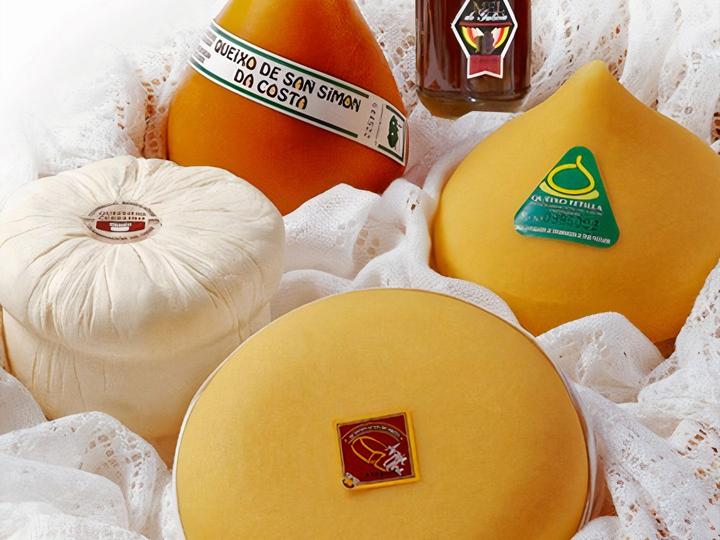There are many products in which Galicia stands out in the culinary field: high-quality wines and emerging varieties with great potential; meats raised using traditional methods that give rise to intense and unique flavors; vegetables adapted to our climate that give rise to indigenous varieties of great value and artisanal products that manage to merge the best of technological progress and the traditions of our land.
If there is a product that meets this last characteristic, it is Galician cheese. The cheese-making tradition in Galicia has achieved worldwide recognition through prizes and awards that recognize the mastery of Galician elaborations. In addition, four of them have a Protected Designation of Origin seal, which recognizes the excellence of the cheeses that are produced, processed and prepared for sale in Galicia. Do you know them all?
Arzua-Ulloa
Of the Galician PDO cheeses, Arzúa-Ulloa is the undisputed champion. Its production covers more than 50% of the cheeses produced with this certification in Galicia. Traditionally known as Cheese from Ulla, from A Ulloa, from Curtis, from Chantada, from Friol or from Arzúa; It is a cheese that can be differentiated into three variants: Arzúa-Ulloa (with a minimum of six days of maturation); farm-raised Arzúa-Ulloa (if it is made with milk from cows on the farm where the cheese is made); and Arzúa-Ulloa cured (with a minimum of six months of maturation).
The entire area of this PDO covers 24 municipalities where the Ulla River plays a leading role in the provinces of A Coruña, Lugo and Pontevedra. The conditions of the Galician cows determine (and much) the high quality of the milk that becomes the beginning of this very successful cheese. From Galician, Friesian or Alpine-brown blondes, it is possible to make a cheese with a very characteristic smell and a buttery appearance. Its versatility is another of its strengths, as it works just as well fresh (with some sweet addition, such as quince or honey) or cooked (it melts especially well). It is an ideal addition in creams and sauces where it complements more penetrating and deep flavors; although it can also succeed on pizzas or hot sandwiches.
Although its PDO has been recognized since 1995, in Arzúa it has been celebrating its famous Festa do Queixo since 1975 on the first weekend of March, where the great protagonist is its iconic cheese.
O Cebreiro

The production area of this cheese covers thirteen municipalities in the eastern region of Lugo and, like that of Arzúa-Ulloa, it must be made with milk from cows of certain breeds: Galician blonde, Alpine-brown and Friesian. The elaboration is carried out with pasteurized whole milk and rennet of animal origin (or other authorized, less common).
How many times have you set career goals that never came to fruition? Actor and writer @MicBennison shares 5 steps… https://t.co/A8e6a2A4HQ
— Spotlight Thu Jul 22 11:02:00 +0000 2021
One of the most striking features of this peculiar cheese is its shape, reminiscent of a mushroom or a "chef's hat". No additive or preservative is added, being a cheese made in a completely natural way, reaching two kilograms in the largest pieces.
The origin and history of O Cebreiro cheese is documented over the years thanks to news, sales records and "invoices" from the time. In fact, it was a tremendously famous and valued cheese thanks to the location of O Cebreiro as the "entrance" to Galicia on the Camino de Santiago, since the pilgrims spread the good work of the area's cheesemakers. Such was the mastery of this elaboration that it reached the tables of Spanish and Portuguese royalty (in fact there is evidence that King Carlos III gave it to his sister the Queen of Portugal with some frequency). Thanks to commercial documents, we can verify that the specialization around this cheese turned Queso do Cebreiro into a luxury product, being one of the most expensive cheeses in Europe (and the first in Spain in 1762).
However, over time, the production of this cheese was closed to a more familiar environment and was about to disappear in 1989. Luckily, thanks to the movement of various craftsmen and the Denomination of Quality Galician Product in 1991, it was made known to the public again and its well-deserved success flourished again.
San Simon da Costa
The production area of this PDO covers the region of Terra Chá, where production in the following municipalities stands out: Vilalba, Muras, Xermade, Abadín, Guitiriz, Begonte, Castro de Rei, Cospeito and A Pastoriza. A cheese that owes all its success to the fantastic production of milk in the province of Lugo.
It is a cheese that was already made in medieval times, where it was common to give it away to family or close friends. Its presence in homes in the area makes it living proof of the Galician way of life. So much so that the Vilalba city council sent two cheeses from San Simón for the Chicago Exposition, as a symbol of the land and its inhabitants. In 1999 its PDO was recognized, consolidating its origin from Galician cows and a birch-based smoked product.
A San Simón cheese is characterized by its smoky flavor and its conical shape. Its interior is oily and semi-elastic, between ocher and yellow, being very soft when cut. In its elaboration, traditional processes are combined with the most advanced technological systems. Thanks to this addition, it is possible to produce an annual average of 400,000 kg of cheese where each unit is studied to the millimeter to meet the demanding quality standards. The future? continue to expand a world market that shows a growing interest in smoked cheeses.
Nipple
Another "best-selling" cheese with Galician PDO, which has the largest geographical extension of this type of product: the entire Autonomous Community of Galicia. Like its "brothers", the production must be made with milk from the Rubia Gallega, Frisona or Pardo-alpina breeds (or their crosses), fed in the traditional way, which ensures the quality of their milk.
Along with Arzúa-Ulloa, Tetilla cheese is one of the best-selling cheeses inside and outside Galicia, selling a whopping 1.7 million kilos during the year 2020. The secret? A cheese with the ideal properties to please everyone. Its flavor, slightly acidic and with a slight salty point, together with its dairy aroma and buttery consistency, makes it work as a starter, dessert, added to salads, a base for pizzas, or a filling for sandwiches, pasta, cannelloni, peppers or empanadas. ).
There are mentions of tetilla cheese since the 18th century, where this cheese received praise throughout its existence, with very important names among its fans: Fray Martín Sarmiento, Lucas Labrada, Pascual Mandoz, L. Martínez de Padín, Ángel Muro or Doña Emilia Pardo Bazán, one of its staunchest defenders.
A whole selection of cheeses that recognize the artisanal production that Galicia has to offer and that is increasingly recognized among the public. What is your favorite?




